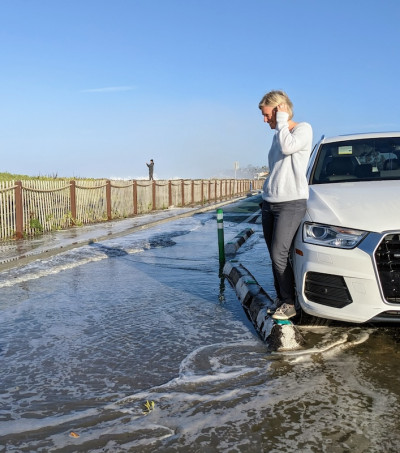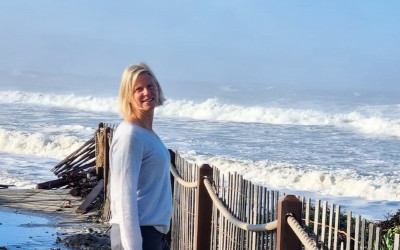As a master’s student at the Middlebury Institute of International Studies at Monterey, Laura Engeman hoped to launch a career in coastal and ocean protection policy. Her faculty advisor suggested she look into an organization called California Sea Grant, which offered a program that placed fellows in state agencies.
Engeman applied and was accepted — and unwittingly found the compass that would guide much of her subsequent career.
“I didn’t know it then, but that fellowship was a perfect launching point,” Engeman says now. After she completed her fellowship in 2007, she was hired and continued at her placement agency — the California Ocean Protection Council (OPC) — for six more years, accumulating experience working with scientists, nonprofits and government agencies. Then, after a stint as the Director of the San Diego Regional Climate Collaborative, she circled back to California Sea Grant in 2019.

For the past six years, Engeman has served as California Sea Grant’s Coastal Resilience Extension Specialist. Last month, as she prepared to move on to a new role in the private sector, Engeman reflected on her tenure with the organization.
In some ways, Engeman says, she never left Sea Grant; in various roles, she wound up mentoring a half-dozen subsequent state fellows. The time at OPC also established a theme that would repeat through her career: boundary crossing, you might call it. The OPC had been established just three years before Engeman’s fellowship. As one of its initial staff members, Engeman found herself collaborating with other agencies, establishing the new office’s purview in a way that did not duplicate existing programs and efforts. She learned the benefits of collaborating across agencies and domains.
“It’s super important to have people who know how to work across those boundaries,” Engeman says.
Engeman’s role with California Sea Grant has also crossed boundaries in a literal way: She holds a dual appointment, serving in overlapping roles as a California Sea Grant Extension Specialist and as Associate Director at the Center for Climate Change and Adaptation at Scripps Institution of Oceanography. She was hired to help launch the latter program, which works to ensure that technical climate science can be applied in the real world.
“It was great timing,” Engeman says. “There have been huge advancements in sea level rise science these past five years. And there’s been a huge demand from nonprofits and local government staff and utilities to come and present, or just answer, questions about the science.”
California Sea Grant is officially headquartered at Scripps, but Engeman's presence in both organizations helped more tightly knit the two: She is able, for example, to steer students toward Sea Grant fellowships and funding opportunities. At both organizations, Engeman has served as a bridge between different worlds: She helps scientists understand what data from climate models might be most useful to local leaders; she helps people in local government trickle their own experiences up into the science.
Engeman worked with local governments and state parks to better understand the frequency of flooding events in their areas, for example. She ensured that what had often been anecdotal observations — “this street floods” — was documented systematically. This information was then tied to models, improving forecasts that give communities advance notice about flooding events.
Sea Grant has also connected her with a broader national network, fostering collaboration with extension specialists across different regions to help federal leaders identify the most valuable data and research needs for local communities. There's been considerable interest from federal agencies in this coordination role, with increasing requests for Sea Grant specialists to review technical reports.

Across the Sea Grant network, Engeman says, she’s found her fellow extension specialists to be good at breaking through the clutter. “We are communicators, at the heart of it,” she says. In her experience, she and her colleagues often notice when federal agencies use different terminology to describe the same thing; they’ve worked together to bring some standardization to these tangled definitions. And they’ve helped federal agencies determine what kind of technical tools are most useful on the ground. Such skills, combined with California Sea Grant’s commitment to the science itself, have allowed Engeman to become a trusted, neutral spokesperson for media on climate science.
One example: LA Times climate reporter Rosanna Xia came to meet with Engeman and her research director about their work. Engeman’s work with the City of Imperial Beach and the California Coastal Dune Science Network — a coalition she first convened in 2019 — was featured in Xia’s book, California Against the Sea.
Engeman says what gives her the most pride are the local partnerships she’s built. In the next phase of her career, she is going to deepen her investment in those relationships: As a consultant with the firm GHD, she will be working with local governments to implement adaptation projects. “It’s exciting to take all that knowledge I’ve gained, all those communication skills I’ve developed, and put them to actionable use, on the ground,” she says.
“But I wouldn’t be qualified for this role if not for my years here, with Sea Grant,” Engeman adds. She hopes her departure will open the chance for someone else to step in, and bring their interests to Sea Grant — pushing the organization in new directions, across new kinds of boundaries. “The beauty of Sea Grant is that it always evolves,” she says.
Watch the special lecture presented by LA Times climate reporter Rosanna Xia, who met with Engeman about her work in Spring 2024 at the Birch Aquarium: